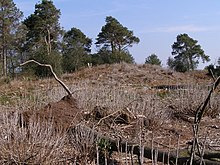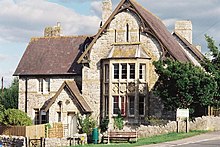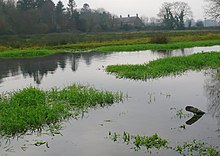Puddletown
| Puddletown | ||
|---|---|---|
Shire county | ||
| Region | ||
| Country | England | |
| Sovereign state | United Kingdom | |
| Post town | DORCHESTER | |
| Postcode district | DT2 | |
| Dialling code | 01305 | |
| Police | Dorset | |
| Fire | Dorset and Wiltshire | |
| Ambulance | South Western | |
| UK Parliament | ||
Puddletown is a village and
Puddletown's parish church has significant architectural interest, particularly its furnishings and monuments. It has a 12th-century font and well-preserved woodwork, including 17th-century box pews. Thomas Hardy took an interest in the church, and the village provided the inspiration for the fictional settlement of Weatherbury in his novel Far from the Madding Crowd; Weatherbury Farm, the home of principal character Bathsheba Everdene, is based on a manor house within the parish.
Toponymy
The name Puddletown means 'farmstead on the River Piddle'. It derives from the
The other rivers of the parish have names that derive from Celtic river-names: the Frome, which forms the parish's southern boundary, means "fair, fine or brisk",[8] and the Devil's Brook, which forms the north-eastern boundary, means "dark stream".[9]
History

Evidence of prehistoric human occupation in the parish exists in the form of 30
The
Part of the arm of a 9th- or 10th-century stone cross was discovered when a house in the village—Styles House, near the River Piddle—was demolished. The cross might have been connected with a meeting place.[12] The fragment was incorporated into the parish church's new chancel when it was rebuilt in 1911.[13]
At the time of the Domesday Book in 1086, Puddletown was a large and important manor that contained several villages, with 1,600 sheep recorded.[14] In the 13th century, during the reign of Henry III, the manor of 'Pidele Bardolfeston town' was owned by John of Monmouth, and leased to Sir Alfred Lincoln: on Monmouth's death, it was inherited by Lady Albretha Boterell and Lady Joan Nevill.[15]
Except for Puddletown village, the several small settlements within Puddletown parish have all either diminished or disappeared. The other settlements were Cheselbourne Ford (beside the Devil's Brook in the northeast of the parish), Bardolfeston (about half a mile northeast of Puddletown village, just north of the River Piddle), Hyde (now Druce Farm), Waterston, South Louvard (now Higher Waterston), Little Piddle (now Little Puddle Farm in neighbouring Piddlehinton parish) and Ilsington (in the south of the parish, by the River Frome). Cheselbourne Ford and Bardolfeston are
In the early 17th century Puddletown was one of the first places in Dorset where the use of watermeadows developed; the practice occurred at least as early as 1620, and in 1629 the manorial court decided to allow some tenants to continue making the necessary watercourses that would enable "the watering and Improvinge of theire groundes".[18] Watermeadows are generally no longer used in southern England, though their physical remnants have persisted in many places;[19] in Puddletown civil parish, several areas of watermeadow were shown by the Ordnance Survey as late as 1978, though none was shown in 2010.[16][20]

Records from 1801 show that at that time agriculture was the main component of Puddletown's economy, though cottage industry and artisan crafts were also an important element: 596 people in the parish were primarily employed in agriculture, with 221 employed in handicrafts, manufacture and trade. Cottage industry, often undertaken by women and children, was used to supplement agricultural income, though there were fewer opportunities for this after the French Revolution.[21]
In 1830, Puddletown was one of the places in Dorset where agricultural labourers took part in the Captain Swing riots of southern England, protesting against very low wages and long working hours. Threshing machines were damaged and ricks burned. Wages were raised from about six or seven shillings per week to ten as a result.[22]
To the east of the church is Ilsington House, also known as the Old Manor, which was built in the late 17th to early 18th century.
Governance
In the UK national parliament, Puddletown is within the
In national parliament and district council elections, Dorset is divided into several electoral wards, with Puddletown lying within Puddletown ward.[27][28][29] In elections to Dorset County Council, Dorset was divided into 42 electoral divisions, with Puddletown being within Linden Lea Electoral Division.[30]
After
Geography

Puddletown civil parish extends between the
The bedrock geology of the parish comprises rocks formed in the
The River Frome, which forms the southern boundary of the parish, is designated by
Demography
In 2014 the estimated population of Puddletown civil parish was 1,452.
Notable buildings
Excluding ancient earthworks, there are fifty-six structures within the parish that are listed by Historic England for their historic or architectural interest, including two (the parish church and Waterston Manor) that are listed as Grade I, and three (Ilsington House, The Old Vicarage, and 8 The Square) that are Grade II*.[40][41]

Puddletown's parish church, dedicated to St Mary, has been described as being "of considerable architectural interest",[10] "of exceptional interest for its furnishings and monuments"[42] and "one of the most exciting parish churches in the county".[43] It has 12th-century origins—parts of the tower date from 1180 to 1200[43]—but was rebuilt and enlarged between the 13th and 16th centuries.[10][42] The 12th-century font is particularly notable, being of a tapering beaker shape, with diapering depicting crossing stems and Acanthus leaves; its cover is an octagonal pyramid dating from about 1635, when the church interior was refitted.[6][10] There is a panelled roof in the nave, and 17th-century box pews, pulpit and gallery. There are also a number of 15th- and 16th-century monumental brasses and some stained glass by Ninian Comper.[44] The South or Martyn family chapel has three 16th-century tombs with alabaster effigies. In 1910 the church was partially restored by Charles Ponting.[10][42] Thomas Hardy led an unsuccessful campaign to prevent enlargement of the original chancel.[43]
Waterston Manor, about 1.5 miles (2.4 km) WNW of Puddletown village, is of early 17th-century origin, though it was largely rebuilt after a fire in 1863, and altered again in about 1911.[45]
Ilsington House dates from the late 17th to early 18th century, with alterations made in the late 18th to early 19th century and enlargement later in the 19th. It has
The Old Vicarage, previously the east wing of the vicarage, was originally a

Community facilities
Puddletown has a
Literary connections
Puddletown is the basis for the village of "Weatherbury" in Thomas Hardy's novel Far from the Madding Crowd.[6] Weatherbury Farm, the house of Bathsheba Everdene, is based on Waterston Manor, between Puddletown and Piddlehinton.[52] Hardy's cousin, Tryphena Sparks, who was the inspiration for Hardy's poem Thoughts of Phena at News of Her Death, lived in Puddletown.[53]
Notable people
See also
- Puddletown Hundred
References
Notes
- ^ ISBN 978-0-19-960908-6.
- ^ "John Speed's Map of Dorset 1610". Charmouth Local History Society. Retrieved 13 May 2017.
- ^ Lewis, Samuel (1848). A Topographical Dictionary of England. British History Online. pp. 567–571. Retrieved 13 May 2017.
- ^ Treves, Sir Frederick (1906). Highways & Byways in Dorset. Macmillan and Co. Ltd. pp. 365–6.
- ^ a b c Wightman 1983, p. 70.
- ^ a b c d e f g Hannay, Clive; Legg, Rodney (September 2006). "Puddletown". Dorset Life Magazine. Retrieved 23 August 2015.
- ^ a b Gant 1980, p. 188.
- ISBN 978-0-19-960908-6.
- ISBN 978-0-19-960908-6.
- ^ a b c d e f g h i j "'Puddletown', in An Inventory of the Historical Monuments in Dorset, Volume 3, Central (London, 1970), pp. 222–231". British History Online. University of London. Retrieved 1 March 2015.
- ^ MacDonagh, Diarmuid (29 January 2011). "Roman road found in Puddletown Forest". dorsetecho.co.uk. Newsquest Media (Southern) Ltd. Retrieved 31 August 2015.
- S2CID 145319552.
- ISBN 9780197263341.
- ISBN 0-7153-6371-9.
- ^ "Inquisitions Post Mortem, Henry III, File 19 Pages 100-104 Calendar of Inquisitions Post Mortem: Volume 1, Henry III". British History Online. HMSO 1904. Retrieved 14 February 2023.
- ^ a b c Ordnance Survey (1978) 1:25,000 Second Series, Sheet SY 69/79 (Dorchester)
- ^ "Medieval settlement immediately west of Waterston House". Historic England. Retrieved 29 May 2017.
- ^ J H Bettey. "The Development of Water Meadows in Dorset during the Seventeenth Century" (PDF). bahs.org.uk (British Agricultural History Society) (scan). pp. 37–39. Retrieved 27 August 2015.
- ^ Bettey, Joseph (1999). "The Development of Water Meadows in the Southern Counties". In Hadrian Cook; Tom Williamson (eds.). Water Management in the English Landscape (PDF). Edinburgh University Press. pp. 179–195. Retrieved 25 April 2017.
- ISBN 978-0-319-24122-6
- ISBN 9780521815802. Retrieved 22 August 2015.
- ISBN 0-7153-6371-9.
- ^ a b "Ilsington House, Puddletown". British Listed Buildings. britishlistedbuildings.co.uk. Retrieved 1 March 2015.
- ^ a b Maslen, Adrianne (7 July 2010). "Dorset's Ilsington Estate on sale for £18million". dorsetecho.co.uk. Newsquest Media (Southern) Ltd. Retrieved 26 August 2015.
- ^ Wightman 1983, p. 75.
- ^ "Welcome to the Puddletown Area Parish Council Website". Puddletown Area Parish Council. Archived from the original on 4 March 2016. Retrieved 24 August 2015.
- ^ "The West Dorset (Electoral Changes) Order 2015". legislation.gov.uk. Retrieved 10 August 2015.
- ^ "Dorset West: Seat, Ward and Prediction Details". electoralcalculus.co.uk. Archived from the original on 1 October 2015. Retrieved 10 August 2015.
- ^ "Interactive map of District councillors". dorsetforyou.com. Dorset County Council. Retrieved 10 August 2015.
- ^ "Electoral division profiles 2013". dorsetforyou.com. Dorset County Council. Retrieved 10 August 2015.
- ^ "Area profile for Puddletown & Lower Winterborne - Dorset Council". gi.dorsetcouncil.gov.uk. Retrieved 24 February 2024.
- ^ ISBN 0-7518-3310-X
- ISBN 0-7028-0327-8
- ISBN 978-0-412-47850-5.
- ^ "COUNTY: DORSET. SITE NAME: RIVER FROME" (PDF). naturalengland.org.uk. Retrieved 29 August 2015.
- ^ "Plan Name: Puddletown" (PDF). Forestry Commission. Retrieved 6 May 2017.
- ^ "Area Profile for Puddletown & Athelhampton". geowessex.com. Dorset County Council. Retrieved 25 December 2016.
- ^ "Area: Puddletown (Parish). Dwellings, Household Spaces and Accommodation Type, 2011 (KS401EW)". Neighbourhood Statistics. Office for National Statistics. Archived from the original on 2 April 2015. Retrieved 1 March 2015.
- ^ "Area: Puddletown (Parish), Key Figures for 2011 Census: Key Statistics". Neighbourhood Statistics. Office for National Statistics. Archived from the original on 16 March 2014. Retrieved 16 March 2014.
- ^ "Listed Buildings in Puddletown, West Dorset, Dorset". britishlistedbuildings.co.uk. Retrieved 31 May 2017.
- ^ "Search Results for 'Puddletown'". Historic England. Retrieved 4 June 2017.
- ^ a b c "Church of Saint Mary, Puddletown". britishlistedbuildings.co.uk. Retrieved 26 August 2015.
- ^ a b c d "Puddletown St Mary's". The Dorset Historic Churches Trust. Archived from the original on 23 September 2015. Retrieved 26 August 2015.
- ^ Betjeman, John, ed. (1968) Collins Pocket Guide to English Parish Churches; the South. London: Collins; p. 176
- ^ "Waterston Manor, Puddletown". britishlistedbuildings.co.uk. Retrieved 24 August 2015.
- ^ "The Old Vicarage Including Garden Walls Adjoining Islington House, Puddletown". britishlistedbuildings.co.uk. Retrieved 26 August 2015.
- ^ "8 the Square, Puddletown". britishlistedbuildings.co.uk. Retrieved 26 August 2015.
- ^ "Puddletown Village Hall". Dorset Halls Network. Dorset Village Halls Association. 2012. Retrieved 30 August 2015.
- ^ "Welcome to Puddletown Community Library". communitylibrarypuddletown.org. Retrieved 31 August 2015.
- ^ "Puddletown Surgery". puddletownsurgery.co.uk. Retrieved 31 August 2015.
- ^ "Puddletown Recreation Ground". sports-facilities.co.uk. Retrieved 30 August 2015.
- ^ a b Gant 1980, p. 190.
- ISBN 0-19-927566-1
General references
- Gant, Roland (1980). Dorset Villages. Robert Hale Ltd. ISBN 0-7091-8135-3.
- Wightman, Ralph (1983). Portrait of Dorset (4 ed.). Robert Hale Ltd. ISBN 0-7090-0844-9.

